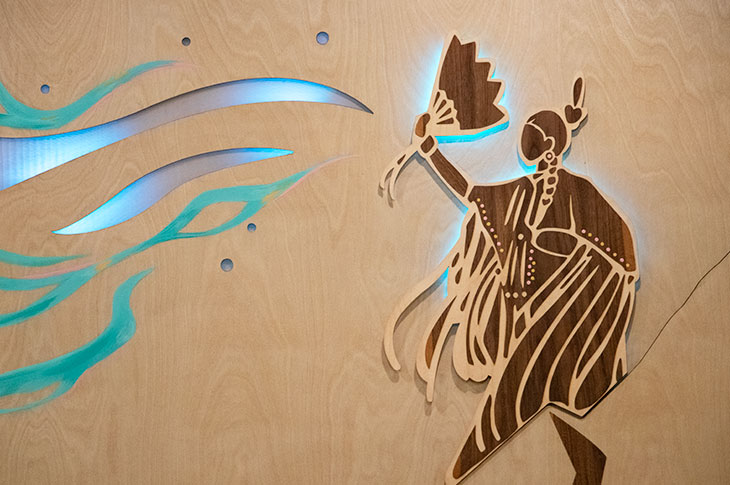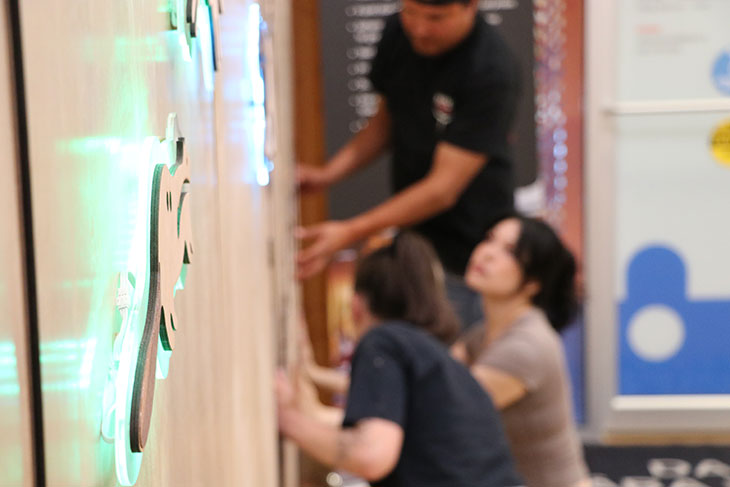Indigenous art installation tells the story of Natoysopoyiis

Artwork by Kristy North Peigan
A new artwork on campus brings the story of SAIT’s Indigenous student support centre’s name, Natoysopoyiis, to life.
Previously called Chinook Lodge, the centre received a new name to connect back to its Blackfoot roots in July 2023. During a traditional pipe ceremony, Elder Miiksika'am (Clarence Wolf Leg) of Siksika Nation named the lodge Natoysopoyiis (nah-toy so-poh-yees), meaning “holy wind lodge” in the language of the Blackfoot people.
“The mural is a welcoming symbol, honouring and reflecting the new name of SAIT’s Indigenous student support centre,” says Catharine Lindland, Director, Student Services. “It’s a beautiful representation of Natoysopoyiis as a gathering place for community and support for Indigenous students.”
Natoysopoyiis
Main artist Kristy North Peigan, a member of the Piikani First Nation, worked with Knowledge Keeper Darren Weaslechild and art collaborator Elder Grant Little Mustache to mesh traditional knowledge with contemporary technologies, creating an immersive mural representing the story of the name Natoysopoyiis:
During the winter, and sometimes in the summer, a quick wet snowstorm comes to our region, covering the ground and freezing everything around. This storm, sometimes referred to as siksopoo (covering wind storm), blankets the ground and melts slowly, bringing moisture to the seeds under the soil.
Elders call this a “holy wind”. This wind teaches us to prepare for unexpected weather change — like in life and unforeseen circumstances, and similar to the experience of many Indigenous students on their post-secondary journey.
“Natoysopoyiis is a home away from home for Indigenous learners at SAIT — it’s important for them to feel welcome and recognized,” says Tapaarjuk Moore, Indigenous Student Advisor, Natoysopoyiis, Student Services. “The mural has transformed the space outside the Lodge and really supports a sense of belonging for Indigenous students.”
The mural comprises engraved wood panels featuring pictographs from Blackfoot stories illuminated from behind with LED strips. The pattern of the lights can be programmed to give the impression of motion, and the colours can be changed for different events or seasons.
A fitting legacy
The Natoysopoyiis mural was funded through SAIT’s ’88 Legacy Fund.
The fund was established in recognition of SAIT’s support of the 1988 Winter Olympic Games — SAIT residence housed athletes and coaches during the Games.
Each year, the ’88 Legacy Fund supports projects that enhance student experience and benefit the SAIT community.
The vision behind the mural — to contribute to a warm welcome for Indigenous students at SAIT, to increase awareness of Indigenous cultures on campus and strengthen relationships with Indigenous communities here in Treaty 7 territory — makes it a natural fit for the program’s funding priorities.
Although led by Natoysopoyiis, the project was closely supported by SAIT’s Facilities Management team, who prepared the physical space, added the new feature lighting and worked with the artist throughout the installation.

Advancing Truth and Reconciliation on campus
The Natoysopoyiis mural project advances SAIT’s ongoing work towards Truth and Reconciliation.
This work includes initiatives to physically transform SAIT's learning environment and help increase the visibility of Indigenous learners and the diverse Indigenous communities on campus.
It also includes efforts to create greater awareness of Indigenous histories and perspectives, such as SAIT’s annual Truth and Reconciliation Event Series and 4 Seasons of Reconciliation training opportunity for learners and employees.
“The mural is a visual representation of the SAIT community's commitment to Truth and Reconciliation and its commitment to Natoysopoyiis,” says Jennifer Russell, Ksik’ksiiniaki (White Buffalo Woman), Director of Indigenous Engagement. “It honours and celebrates Natoysopoyiis, Indigenous students at SAIT and the whole SAIT community.”


Oki, Âba wathtech, Danit'ada, Tawnshi, Hello.
SAIT is located on the traditional territories of the Niitsitapi (Blackfoot) and the people of Treaty 7 which includes the Siksika, the Piikani, the Kainai, the Tsuut’ina and the Îyârhe Nakoda of Bearspaw, Chiniki and Goodstoney.
We are situated in an area the Blackfoot tribes traditionally called Moh’kinsstis, where the Bow River meets the Elbow River. We now call it the city of Calgary, which is also home to the Métis Nation of Alberta.